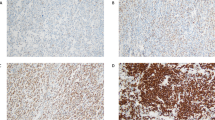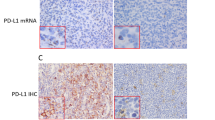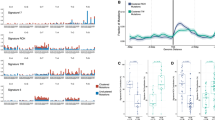Abstract
Gene expression profiling has identified two major molecular subtypes of diffuse large B-cell lymphoma (DLBCL) that are histologically indistinguishable but differ in cure rates. Here, we investigated whether the isotype of the B-cell receptor (BCR) expressed by the tumoral cells correlated with the molecular subtype and survival. Gene expression analysis clustered the 53 patients included in this study into three subgroups, 17 germinal center B-cell-like (GCB) cases, 26 activated B-cell-like (ABC) cases and 10 intermediate cases. The molecular subtype was correlated with the isotype, as 15/17 GCB cases expressed a secondary isotype (immunoglobulin (Ig)G or IgA), whereas 24/26 ABC cases expressed a primary isotype (IgM or IgD) (P<0.0001). There was a trend toward a worse outcome for patients with an ABC DLBCL and a shorter overall survival for patients with IgM+ tumor (P=0.21 and 0.014, respectively). Finally, fluorescence in situ hybridization (FISH) analysis revealed a striking asymmetric pattern, as the IGHM gene is conserved only on the productive IGH allele in most IgM+ tumors. Taken together, these data indicate that the isotype of the BCR is a reliable indicator for the GCB and ABC subtypes in DLBCL, and suggest that the conservation of an IgM is required for ABC DLBCL lymphomagenesis to occur.
This is a preview of subscription content, access via your institution
Access options
Subscribe to this journal
Receive 12 print issues and online access
$259.00 per year
only $21.58 per issue
Buy this article
- Purchase on Springer Link
- Instant access to full article PDF
Prices may be subject to local taxes which are calculated during checkout





Similar content being viewed by others
Accession codes
References
Alizadeh AA, Eisen MB, Davis RE, Ma C, Lossos IS, Rosenwald A et al. Distinct types of diffuse large B-cell lymphoma identified by gene expression profiling. Nature 2000; 403: 503–511.
Hans CP, Weisenburger DD, Greiner TC, Gascoyne RD, Delabie J, Ott G et al. Confirmation of the molecular classification of diffuse large B-cell lymphoma by immunohistochemistry using a tissue microarray. Blood 2004; 103: 275–282.
de Jong D, Rosenwald A, Chhanabhai M, Gaulard P, Klapper W, Lee A et al. Immunohistochemical prognostic markers in diffuse large B-cell lymphoma: validation of tissue microarray as a prerequisite for broad clinical applications—a study from the Lunenburg Lymphoma Biomarker Consortium. J Clin Oncol 2007; 25: 805–812.
Wright G, Tan B, Rosenwald A, Hurt EH, Wiestner A, Staudt LM . A gene expression-based method to diagnose clinically distinct subgroups of diffuse large B cell lymphoma. Proc Natl Acad Sci USA 2003; 100: 9991–9996.
Jais JP, Haioun C, Molina TJ, Rickman DS, de RA, Berger F et al. The expression of 16 genes related to the cell of origin and immune response predicts survival in elderly patients with diffuse large B-cell lymphoma treated with CHOP and rituximab. Leukemia 2008; 22: 1917–1924.
Lenz G, Nagel I, Siebert R, Roschke AV, Sanger W, Wright GW et al. Aberrant immunoglobulin class switch recombination and switch translocations in activated B cell-like diffuse large B cell lymphoma. J Exp Med 2007; 204: 633–643.
Shaffer AL, Rosenwald A, Staudt LM . Lymphoid malignancies: the dark side of B-cell differentiation. Nat Rev Immunol 2002; 2: 920–932.
Lossos IS, Levy R, Alizadeh AA . AID is expressed in germinal center B-cell-like and activated B-cell-like diffuse large-cell lymphomas and is not correlated with intraclonal heterogeneity. Leukemia 2004; 18: 1775–1779.
van Dongen JJ, Langerak AW, Bruggemann M, Evans PA, Hummel M, Lavender FL et al. Design and standardization of PCR primers and protocols for detection of clonal immunoglobulin and T-cell receptor gene recombinations in suspect lymphoproliferations: report of the BIOMED-2 Concerted Action BMH4-CT98-3936. Leukemia 2003; 17: 2257–2317.
Brochet X, Lefranc MP, Giudicelli V . IMGT/V-QUEST: the highly customized and integrated system for IG and TR standardized V–J and V–D–J sequence analysis. Nucleic Acids Res 2008; 36: W503–W508.
Lossos IS, Okada CY, Tibshirani R, Warnke R, Vose JM, Greiner TC et al. Molecular analysis of immunoglobulin genes in diffuse large B-cell lymphomas. Blood 2000; 95: 1797–1803.
Lenz G, Wright G, Dave SS, Xiao W, Powell J, Zhao H et al. Stromal gene signatures in large-B-cell lymphomas. N Engl J Med 2008; 359: 2313–2323.
Nardini E, Rizzi S, Capello D, Vitolo U, Gaidano G, Menard S et al. Most immunoglobulin heavy chain switch mu rearrangements in B-cell chronic lymphocytic leukemia are internal deletions. FEBS Lett 2002; 518: 119–123.
Vaandrager JW, Schuuring E, Kluin-Nelemans HC, Dyer MJ, Raap AK, Kluin PM . DNA fiber fluorescence in situ hybridization analysis of immunoglobulin class switching in B-cell neoplasia: aberrant CH gene rearrangements in follicle center-cell lymphoma. Blood 1998; 92: 2871–2878.
Montesinos-Rongen M, Schmitz R, Courts C, Stenzel W, Bechtel D, Niedobitek G et al. Absence of immunoglobulin class switch in primary lymphomas of the central nervous system. Am J Pathol 2005; 166: 1773–1779.
Miyazaki K, Yamaguchi M, Suguro M, Choi W, Ji Y, Xiao L et al. Gene expression profiling of diffuse large B-cell lymphoma supervised by CD21 expression. Br J Haematol 2008; 142: 562–570.
Wilkins BS, Williamson JM, O’Brien CJ . Morphological and immunohistological study of testicular lymphomas. Histopathology 1989; 15: 147–156.
Hoefnagel JJ, Dijkman R, Basso K, Jansen PM, Hallermann C, Willemze R et al. Distinct types of primary cutaneous large B-cell lymphoma identified by gene expression profiling. Blood 2005; 105: 3671–3678.
Koens L, Vermeer MH, Willemze R, Jansen PM . IgM expression on paraffin sections distinguishes primary cutaneous large B-cell lymphoma, leg type from primary cutaneous follicle center lymphoma. Am J Surg Pathol 2010; 34: 1043–1048.
Booman M, Douwes J, Glas AM, de JD, Schuuring E, Kluin PM . Primary testicular diffuse large B-cell lymphomas have activated B-cell-like subtype characteristics. J Pathol 2006; 210: 163–171.
Camilleri-Broet S, Criniere E, Broet P, Delwail V, Mokhtari K, Moreau A et al. A uniform activated B-cell-like immunophenotype might explain the poor prognosis of primary central nervous system lymphomas: analysis of 83 cases. Blood 2006; 107: 190–196.
Hummel M, Berry JK, Dunnick W . Switch region content of hybridomas: the two spleen cell Igh loci tend to rearrange to the same isotype. J Immunol 1987; 138: 3539–3548.
Radbruch A, Muller W, Rajewsky K . Class switch recombination is IgG1 specific on active and inactive IgH loci of IgG1-secreting B-cell blasts. Proc Natl Acad Sci USA 1986; 83: 3954–3957.
Luby TM, Schrader CE, Stavnezer J, Selsing E . The mu switch region tandem repeats are important, but not required, for antibody class switch recombination. J Exp Med 2001; 193: 159–168.
Khamlichi AA, Glaudet F, Oruc Z, Denis V, Le BM, Cogne M . Immunoglobulin class-switch recombination in mice devoid of any S mu tandem repeat. Blood 2004; 103: 3828–3836.
Zhang T, Franklin A, Boboila C, McQuay A, Gallagher MP, Manis JP et al. Downstream class switching leads to IgE antibody production by B lymphocytes lacking IgM switch regions. Proc Natl Acad Sci USA 2010; 107: 3040–3045.
Horikawa K, Martin SW, Pogue SL, Silver K, Peng K, Takatsu K et al. Enhancement and suppression of signaling by the conserved tail of IgG memory-type B cell antigen receptors. J Exp Med 2007; 204: 759–769.
Sciammas R, Shaffer AL, Schatz JH, Zhao H, Staudt LM, Singh H . Graded expression of interferon regulatory factor-4 coordinates isotype switching with plasma cell differentiation. Immunity 2006; 25: 225–236.
Staudt LM . Oncogenic activation of NF-kappaB. Cold Spring Harb Perspect Biol 2010; 2: a000109.
Acknowledgements
This work was supported by grants from the Ligue contre le Cancer (comité Seine Maritime), the ‘Agir avec Becquerel’ association, the GEFLUC association and the Institut National du Cancer (INCa, Grant no. PL070-2005, Professor T Fest, Rennes).
Author information
Authors and Affiliations
Corresponding author
Ethics declarations
Competing interests
The authors declare no conflict of interest.
Additional information
Supplementary Information accompanies the paper on the Leukemia website
Supplementary information
Rights and permissions
About this article
Cite this article
Ruminy, P., Etancelin, P., Couronné, L. et al. The isotype of the BCR as a surrogate for the GCB and ABC molecular subtypes in diffuse large B-cell lymphoma. Leukemia 25, 681–688 (2011). https://doi.org/10.1038/leu.2010.302
Received:
Revised:
Accepted:
Published:
Issue Date:
DOI: https://doi.org/10.1038/leu.2010.302
Keywords
This article is cited by
-
Outcome prediction by interim positron emission tomography and IgM monoclonal gammopathy in diffuse large B-cell lymphoma
Annals of Hematology (2023)
-
Combining gene expression profiling and machine learning to diagnose B-cell non-Hodgkin lymphoma
Blood Cancer Journal (2020)
-
IgCaller for reconstructing immunoglobulin gene rearrangements and oncogenic translocations from whole-genome sequencing in lymphoid neoplasms
Nature Communications (2020)
-
Immunoglobulin gene rearrangement IGHV3-48 is a predictive marker of histological transformation into aggressive lymphoma in follicular lymphomas
Blood Cancer Journal (2019)
-
Integrative systems medicine approaches to identify molecular targets in lymphoid malignancies
Journal of Translational Medicine (2016)



